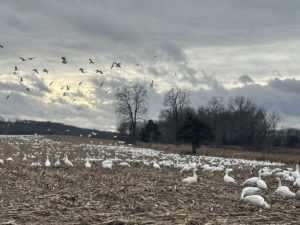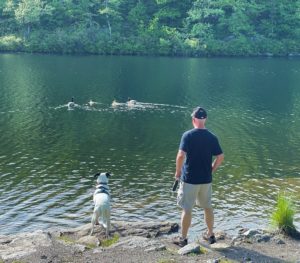Hello fellow readers, Snow geese and Canadian geese are glorious to many but pests to some bringing a lesson of acceptance I hope you’ll enjoy.
As I drove to the Karen Ann Quinlan Home for Hospice for my weekly volunteer sing, an enormous flock of snow geese was feeding on the farm field across from home. As I arrived, my singing buddy, Ken Roberts, pulled in next to me. “A goose can take down a plane,” he said. Ken is a retired United Airlines Captain, though he rarely mentions it. I didn’t ask for specifics, but I thought he might be speaking of the plane that landed on the Hudson River.
You recall the story coined “The Miracle on the Hudson” when US Airways Flight 1549 made a heroic landing. There were injuries, but no fatalities, which was indeed miraculous. For those folks on the plane, a field of geese may remind them of that frightening day while many see their beauty.
 The first time I saw snow geese was during a flight with a long-ago friend from my days at KISS FM radio in NYC. Jonathan Taylor, known as JT at the time, was the station engineer and on-air talent. We reconnected on social media six years ago, and he flew into Blairstown Airport and invited us for a ride.
The first time I saw snow geese was during a flight with a long-ago friend from my days at KISS FM radio in NYC. Jonathan Taylor, known as JT at the time, was the station engineer and on-air talent. We reconnected on social media six years ago, and he flew into Blairstown Airport and invited us for a ride.
It was an exciting feeling being in a small plane amongst the birds – gratefully at a safe distance. Birds served as an archetype for the invention of airplanes. And now we fly amongst them. We tend to forget about the miracle of that.
Snow geese always migrate, while Canadian geese only sometimes do.
Snow geese are migratory, unlike Canadian geese, which don’t always migrate, though about fifty years ago, they did. They say the large expanses of lawn areas created by suburban sprawl and office developments turned into a perfect goose habitat, so why take the risk to migrate? Although some flocks still do.
Anser caerulescens, the scientific name for snow geese, are primarily white with black wing tips but a bit smaller than Canadian geese and have pink bills. Some have dark plumage and are called Blue Geese. They nest in the Artic tundra and commonly migrate here. It used to be they’d winter in the salt marshes and farm fields in south jersey along the coastline and along the Delaware Bay shores. But now they are throughout the area.
Feather Folklore
In Song of the North Wind: A Story of the Snow Goose, Paul Johnsgard writes about a boy in North Dakota who “measured winters” by geese migration, as did native Americans for centuries.
Folklore has it that feathers symbolize the love and protection of guardian angels and the connection to God or our creator. White feathers, especially when seen after losing a loved one, are thought to be a message of love and protection from them.
 There was a time when snow geese were considered scarce, but because of how we farm fields, the theory is they’ve made a remarkable comeback to the point of being considered an annoyance to some. Most farm fields are monocultures (one crop), which is not ideal for the earth. But a perfect landing strip and feeding ground for geese.
There was a time when snow geese were considered scarce, but because of how we farm fields, the theory is they’ve made a remarkable comeback to the point of being considered an annoyance to some. Most farm fields are monocultures (one crop), which is not ideal for the earth. But a perfect landing strip and feeding ground for geese.
The Paradox of Beautiful and Ugly
Due to growing populations, these beautiful birds are considered pests and, therefore, ugly to some. What’s interesting is if we didn’t think of something as beautiful, we wouldn’t consider something else ugly. We label them as such instead of just observing them just as they are. Plants and animals likely don’t think that way. A daffodil and a tulip in a garden don’t look at each other as ugly or beautiful. At least, I don’t think they do.

With acceptance, we can all live together peacefully.
It turns out it was a flock of nonmigratory Canadian geese that the miracle on the Hudson plane hit. Since then, USDA scientists have increased efforts to help birds get out of the way, attempting to develop warning light systems. And experiments are underway using avian radars to help identify potential problems.
Since banning the pesticide DDT and tightening up hunting regulations, bald eagles and the populations of most large flocking birds have increased markedly in the last few decades. The North American snow goose population has tripled from 1990 to 15 million. Traveling in massive groups creates “predator confusion,” much like fish swimming in schools. Indeed, there can be safety in numbers if everyone gets along. And there’s there is strength in our community.
Garden Dilemma? AskMaryStone@gmail.com and your favorite Podcast App.


